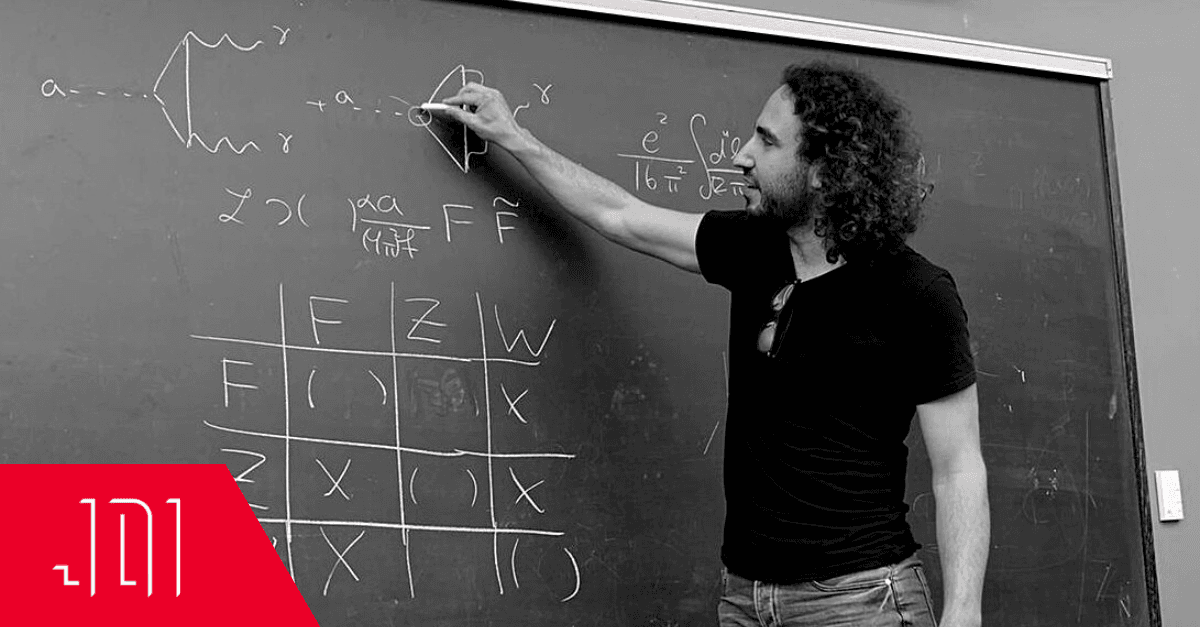Q&A with Dr. Jeff Dror
Tell us about yourself -- what is your background in and how did you end up in your current position?
I'm a physicist at the University of California, Santa Cruz. I work in a couple of different fields – on the bridge between particle physics and cosmology, and astrophysics, so kind of touching upon all these different, seemingly quite separate fields. My inspiration is trying to understand the kind of the world around us at the smallest possible scales. The fascinating thing about physics is the biggest parts of our universe are actually intimately tied to the smallest parts of the universe. If you want to understand what's happening right in front of you, you can try to look at what's happening in the very biggest things around us, and learn a lot about what's happening in the smallest of sizes along the way.
I've been kind of working in physics for many years now: I started initially trying to understand a lot more about collider physics experiments like the Large Hadron Collider (LHC). I then slowly moved into different realms trying to understand different questions, which led me to my current approach where I'm working between particle physics, cosmology, and astrophysics.
Tell us about the Santa Cruz Institute for Particle Physics and the research that goes on there?
When I accepted my position here at the SCIPP, I was excited to come here because the institute has a broad research interest. We have work from a range of fields, some relating purely to understanding stars and black holes; very astrophysics-related questions. Then we also have work about the LHC and everywhere in between. While the research interests are so diverse, we're all unified with our mission, to understand physics at the largest to the smallest scales.
What are axions and how do they let humans learn about the very early universe?
The axion is an idea initially proposed back in the early 80s. It solves an integral problem with the neutron. In particle physics, there are fundamental particles, which are the smallest units not made up of anything else: they just are themselves. Electrons, quarks, photons, and the theoretical axion fall into this category. On the other hand, neutrons are made up of three quarks. Studying the neutron, we learned that the 3 quarks are not arbitrarily sprinkled around, but instead are mysteriously placed along a straight line. The axion offers a solution to that puzzle.
The axion is a very light particle, with a mass way below that of the proton or electron that we have around us today. Particle physicists expect that in the early universe, axions were produced and were abundant. What we’re trying to do is look back in time, by looking for those axions and see a snapshot of our very early universe. The axion has been the focus of a huge program around the world: by constructing experiments that prove its existence, discover how it works, and how it fits into our model of the universe.
To date, our best probe into the early universe is a collection of photons produced around 100,000 years after the Big Bang, and nuclei, produced around 1 min after the Big Bang. These fossils of the universe give us an idea of events that took place at that time. Just like with archaeological fossils, particles from the early universe come from different periods of time and evolution.
Discovering axions, and these ones especially, would give us a more complete picture of what was happening in the universe during the foundational stages. Most of our information comes from these photons and nuclei, meaning that we really only understand the universe after these particles were created. We have no idea what happened in the first minute of the universe – there are conjectures and ideas, all of which say that it was the hottest and most dramatic time in our universe. Getting a glimpse of that time period would help us go from knowing nothing to knowing a whole lot.
How is the Cosmic Axion Background related to dark matter?
When we try to look for a fossil from the early universe it can have different speeds: The nuclei that are around us today have speeds of about one-one-thousandth of the speed of light, which might seem fast to some people, but it's actually very slow from the perspective of a cosmologist. Photons themselves are relativistic, meaning they're moving at the speed of light.
So the question would be, suppose we find an axion from the early universe, which of those two categories would it be? Would it be similar to the photons that move relativistically? Or would it be similar to nuclei that would be non-relativistically? And depending on those two cases, we would classify that as being dark matter if it's slow today, or if it's fast, we would classify that as being the cosmic axion background. So that's kind of been the terminology that's being used to separate out those two cases. Depending on which case is at play, you would learn different things about the early universe – it turns out that studying how fast something is is a very good indicator of what really happened at early times.
What recent research in the field of theoretical particle physics has been most exciting to you?
Some work that I am thinking about now – that's quite different from the realm of axions – is trying to understand the biggest compact objects in our universe, also known as supermassive black holes. They're called supermassive because they're extremely heavy: roughly a million times heavier than the mass of the Sun, up to about a billion times heavier than the mass of the Sun. So these are just gigantic, gigantic objects in truly their most compact form.
What's really interesting about supermassive black holes and how we're able to study them today, is that they merge. In the early universe, these objects could come into contact with one another, and begin a process called inspiraling. Similar to some debris circling a drain, they would continually move closer and closer together, and eventually meet at a singular point. This process emits gravitational waves that we can detect today.
I recently submitted a paper developing a new technique to search for gravitational waves and find supermassive black holes, Using Pulsar Parameter Drifts to Detect Sub-Nanohertz Gravitational Waves. We put together a new theoretical technique and applied it to publicly available data. While we didn't find a signal just yet, in the few years to maybe decade timescale, we have a strong expectation that this will indeed find a signal as we refine our approach.
To carry out our analysis, we looked at these special stars around the galaxy called pulsars. Pulsars rotate extremely rapidly – about once every millisecond. Compared to other astronomical bodies, think about how fast the earth rotates once per day, and even our Sun, which is once every 24.5 days. A pulsar is rotating a thousand times in a second – an outrageously fast pace. We’re able to tell this because they also beam a flash of light, like a lighthouse, as they're going around and around. So every millisecond, these pulsars are flashing light at us. And the idea is that we can stare at this light, and then use this light as a clock just like you would a clock on your wall. Every tick of the clock is one time this pulsar is going around. Since we have these clocks that are scattered all over the galaxy, we can try to look for any kind of patterns that would deviate away from being a constant clock.
For example, if the Earth moves, "back and forth" you can observe this motion by just staring at these far off clocks. One phenomena that can induce Earth motion is gravitational waves from supermassive black holes. What our method allows you to do, is detect the Earth moving in a single motion, instead of needing to see it move "back and forth", we are now able to see just "back" or "forth". This is a huge advantage as it dramatically improves the types of gravitational waves you can discover. In five to ten years, we will have more and better telescopes to stare at these pulsars. Over time, we're also looking for longer, and the longer you stare at a pulsar, the more you understand the nuances of that singular star, and the better clock it becomes. We will have more data coming in the near future, and will also have better data because the instruments are also improving at the same time.
What is on the horizon for theoretical particle physics?
It's a very interesting time to be a particle physicist! If you look back 10-15 years ago, around when I started to be a graduate student, a transition was beginning. If you ask somebody 15 years ago this same question, most particle physicists would immediately have the same answer: to work with and understand the data that’s coming out of the LHC. It was just starting up at the time, just ramping up, finishing the first part of this massive investment. The project itself is tens of kilometers long and costs billions and billions of dollars to complete. It's a very, very powerful experiment. All of us centered our energies trying to understand the data coming out of this collider.
But in the last 10 years, there has not been a massive discovery of a new particle or an experiment that rewrote our laws of physics as was expected for the data. Many of us have been transitioning into trying to understand what other ways we can try to understand particle physics, outside of smashing particles together at the highest energies like the LHC does.
I would say it's actually a much more interesting time we find ourselves in now, because we're not all working in one direction. Instead, we have particle physicists around the globe studying a wide range of questions. I might look for the axion, while somebody else might be trying to understand photons from the early universe, while somebody else is trying to work on the Large Hadron Collider, and try to understand what's happening there in greater and greater detail. So particle physics is seeing a huge diversity of ideas right now – which makes it all the more exciting.
What is your “path not taken” – what were you choosing between? Where would you be if you went the other direction when you got to that fork in the road?
Well, when I was 10, I wanted to be an NHL player, but that failed pretty fast. More seriously, I've always seen myself going into sciences. I've been interested in research, pretty much ever since I started in undergrad. I had it in my mind early on, that perhaps I wanted to go into medicine, but when I reflect back now, I think that path would have never made too much sense for me. The reason I am pulled toward fundamental physics is because it's more about trying to understand the mechanisms at play, and less about knowledge itself. What I found most intriguing was that physics is trying to build an understanding of a system – down to its imperceptibly small parts.





